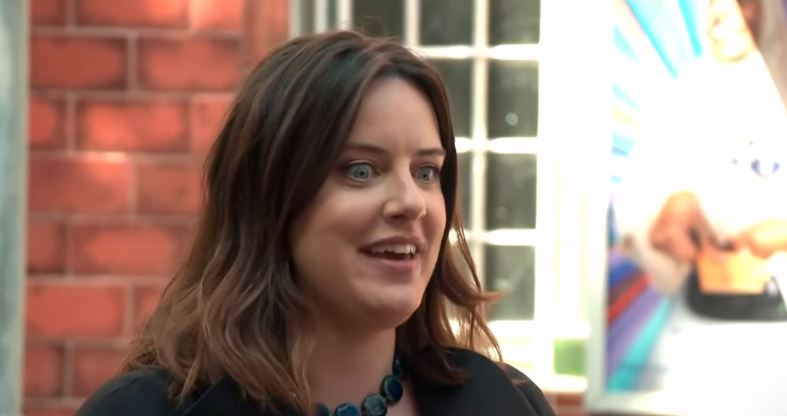
Fans noticed a change when Michelle Ryan returned to the screen in the middle of 2025. Her demeanor seemed warmer, her energy calmer, and her face fuller. Her apparent weight gain sparked a flurry of comments on social media, which, as usual, revealed more about the public’s obsession than the individual.
Discussions quickly swept through EastEnders fan groups on Facebook and Reddit in June 2025. Some kind remarks praised the fact that “she still looks lovely, just more grown.” Others were crueler, analyzing her looks with surgical iciness. However, as the dust settled, the voices that were more audible were those that were encouraging, complimenting her self-assurance and inherent beauty.
| Label | Information |
|---|---|
| Name | Michelle Claire Ryan |
| Born | April 22, 1984 — Enfield, London, England |
| Occupation | Actress |
| Known For | Zoe Slater in EastEnders; Bionic Woman; Doctor Who (Lady Christina de Souza) |
| Years Active | 2000 – Present |
| Recent Work | EastEnders 2025 return; Finding My Voice (film, 2026); Frankenstein Legacy |
| Social Media | Instagram — @michelleryan008 |
| Reference | The Sun — https://www.thesun.co.uk/tv/soaps |
Michelle, surprisingly, said nothing. No PR spin, no defensive post, no statement. Her cool detachment seemed deliberate, almost rebellious. She forced the audience to ask why an actress’ body should be news at all by turning the conversation inward by refusing to join the clamor.
The changes in her appearance were especially apparent when she returned to EastEnders to play the iconic role of Zoe Slater. Those who grew up watching her in the early 2000s began comparing her then and now, failing to remember that “now” is a 41-year-old woman and “then” was a 16-year-old girl. The double standard was remarkably similar to the expectation that time should be kind but invisible that actresses like Kate Winslet and Renée Zellweger once had to deal with.
The Sun revealed over the summer that Ryan was working with Tracy Shaw and Vicki Michelle on a new film called Finding My Voice. That title was almost poetic in its irony. Following years of relative silence, Michelle was making a comeback in a number of projects, reclaiming her artistic presence in addition to acting. Her work spoke for her; she didn’t have to explain herself.
It’s easy for people who recall her smoldering scenes with Jessie Wallace as Kat Slater to forget how pivotal that period was for British television. The line “You ain’t my mother!” continues to reverberate in popular culture, serving as a shorthand for the most unfiltered soap opera emotion. Her comeback twenty years later had an equally significant impact, but this time it was for authenticity rather than scandal or spectacle.
Her development was mirrored in the plot when Ryan returned in 2025 as Zoe. The brash teen was no longer there; instead, viewers saw a woman who was emotionally torn, visually human, and weathered by life. She wasn’t overly stylized, glamorized, or filtered. One fan described it as “refreshingly real.” Presenting her in her natural state felt like a creative protest against the unrelenting youth obsession with television.
The fact that there was a pattern in the public’s reaction is particularly intriguing. Curiosity initially evolved into judgment. Then, slowly, compassion took over. Her appearance as “someone you could actually know” drew praise from viewers. Ryan’s natural appearance was practically revolutionary in a field where Facetune, fillers, and filters predominate.
By September, TikTok videos of her performance were popular, and many people were complimenting her subtle emotional delivery. She appears to be confident, content, and healthy, according to one comment that went viral. I’ll accept it if it means gaining weight. These messages reflected the changing attitude, which was one of acceptance rather than shame.
A growing shift in entertainment culture was also reflected in her journey. Audiences have spoken out against body shaming more and more in recent years. People are gradually realizing that physical change does not equate to personal decline, as evidenced by Selena Gomez’s discussion of her lupus-related changes and Brendan Fraser’s emotional comeback to acting. Michelle Ryan’s predicament is a perfect example of this turning point, demonstrating that when humanity is shown, it resonates far more than perfection.
It became evident by the beginning of autumn that Michelle was not withdrawing into solitude this time. Her Instagram presence gradually expanded, featuring images of quiet reflections, film sets, and outdoor walks. Every post exuded a feeling of serene contentment. There was just a woman going about her life, unapologetic, without any dramatization.
One of the best comments on Reddit summed up the change quite nicely: “She looks like a real person.” We’ve all grown so accustomed to seeing still faces that we’ve forgotten what a natural face looks like. It was a strikingly obvious observation: what some people interpreted as a sign of decline was actually proof of self-acceptance.
Michelle Ryan accomplished something that many public figures don’t: she let her art take precedence over her image by remaining silent. The emotional range that once made Zoe Slater iconic is expected to be on display in her new projects, especially Finding My Voice. Her tenacity, not her weight, is what has her fans excited.
It is important to keep in mind that this story is cyclical. A female celebrity is scrutinized every few years for aging, changing, and existing outside of expectations. However, Michelle’s story seems noticeably different for some reason. She has made progress, as evidenced by the support she has received from both fans and other actors. Judgement is gradually being replaced by empathy.
As a reminder of how those characters influenced a generation of viewers, her return also rekindled nostalgia for early EastEnders. Like Zoe in real life, Michelle’s portrayal of her was intense, flawed, and incredibly human. Her development seems natural, spontaneous, and exquisitely flawed.
The true story is found elsewhere, despite some headlines that tried to sensationalize her physical change. She has resumed acting, is flourishing creatively, and gracefully manages her career. It is a tale of continuity rather than change.
Ryan has unintentionally brought attention to the way that viewers absorb celebrity narratives by using her increased visibility. According to her experience, society’s definition of beauty may finally be changing. Now, the praise is louder than the criticism, and the praise lasts longer than the rumors.
Michelle Ryan serves as a reminder that authenticity endures in a society that frequently values appearance over artistic ability. Her journey from adolescent stardom to midlife comeback serves as an example of how reinvention isn’t always necessary. Sometimes it’s enough to just be yourself.

